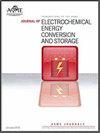The characteristics of a novel after-burner used for metal-supported planar SOFC system
IF 2.7
4区 工程技术
Q3 ELECTROCHEMISTRY
Journal of Electrochemical Energy Conversion and Storage
Pub Date : 2022-09-23
DOI:10.1115/1.4055773
引用次数: 1
Abstract
A novel after-burner used for the heat-up and normal operating conditions of metal-supported planar solid oxide fuel cell (SOFC) system, is designed and experimentally studied in this paper. The burner construction and the calculation of maximum burner power are showed in detail. Meanwhile, its static characteristics are researched through the influence of excess air ratio (ER), air velocity, inlet air temperature and fuel utilization rate (Uf); its transient characteristics are researched through the processes of burner start-up, burner operating state switch and stack start-up. Results suggest that the best ER value gets larger with the increased burner power. The air velocity is better controlled within 3 m·s-1 to prevent the influence of lifted flame. High inlet air temperature can extend lean combustion range and reduce incomplete combustion products, but large ER mutation should still be avoided. In case of anode off gas combusting with cathode off gas, there are nearly zero emissions. Meanwhile, the flue gas temperature decreases to about 760 °C because of enlarged heat loss, but it is minimally influenced by Uf. Under static condition, the optimal point with both controlled temperature and lowest emissions can be obtained in wide range, and the after-burner can well adapt to various operating states of the stack. Under transient condition, the after-burner has good response performance with much shorter time in burner start-up and burner operating state switch than conventional porous media ones. It can start up the stack in 1715 seconds.金属支撑平面SOFC系统新型加力燃烧器的特点
设计了一种用于金属支撑平面固体氧化物燃料电池(SOFC)系统加热和正常工作的新型加力燃烧器,并对其进行了实验研究。详细介绍了燃烧器的结构和最大功率的计算方法。同时,通过过量空气比(ER)、风速、进气温度和燃料利用率(Uf)对其静态特性的影响进行了研究;通过燃烧器启动、燃烧器工作状态切换和炉膛启动过程,研究了其瞬态特性。结果表明,最佳ER值随着燃烧器功率的增大而增大。风速最好控制在3 m·s-1以内,以防止火焰上升的影响。高进气温度可以延长稀薄燃烧范围,减少不完全燃烧产物,但仍应避免较大的ER突变。在阳极废气与阴极废气混合燃烧的情况下,几乎没有排放。同时,由于热损失增大,烟气温度降至760℃左右,但Uf对烟气温度的影响最小。在静态条件下,可以在较宽的范围内获得温度可控和排放最低的最优点,加力燃烧室可以很好地适应烟台的各种工作状态。在瞬态条件下,加力燃烧器具有较好的响应性能,与传统多孔介质燃烧器相比,加力燃烧器启动和运行状态切换的时间大大缩短。它可以在1715秒内启动堆栈。
本文章由计算机程序翻译,如有差异,请以英文原文为准。
求助全文
约1分钟内获得全文
求助全文
来源期刊

Journal of Electrochemical Energy Conversion and Storage
Engineering-Mechanics of Materials
CiteScore
4.90
自引率
4.00%
发文量
69
期刊介绍:
The Journal of Electrochemical Energy Conversion and Storage focuses on processes, components, devices and systems that store and convert electrical and chemical energy. This journal publishes peer-reviewed archival scholarly articles, research papers, technical briefs, review articles, perspective articles, and special volumes. Specific areas of interest include electrochemical engineering, electrocatalysis, novel materials, analysis and design of components, devices, and systems, balance of plant, novel numerical and analytical simulations, advanced materials characterization, innovative material synthesis and manufacturing methods, thermal management, reliability, durability, and damage tolerance.
 求助内容:
求助内容: 应助结果提醒方式:
应助结果提醒方式:


